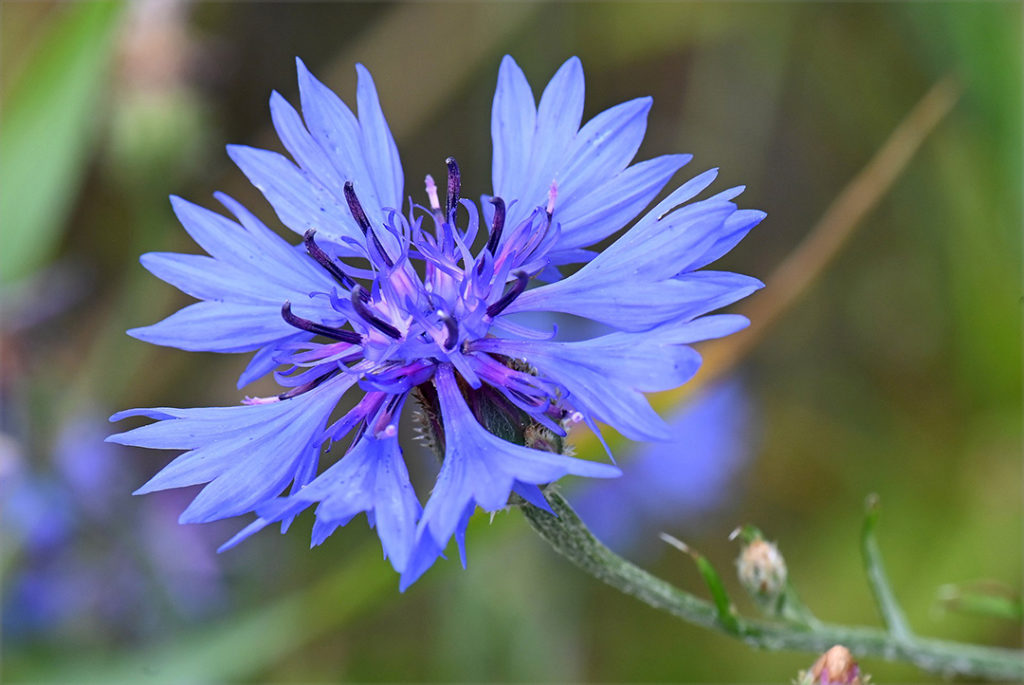
Estonia
Cornflower
Centaurea cyanus

General Description / Cultural Significance
The cornflower, Centaurea cyanus, has grown on Estonian soil for more than 10,000 years, since the first humans came to Northern Europe. The plant grows in rye fields, meaning in the minds of Estonians, there is a strong connection between the flower and their daily bread. For decades, artists have created decorative representations of the iconic cornflower, portraying its striking graphic appearance. The flower was chosen in 1968 to be the national flower, and it has always been considered a symbol of resistance. The color of the Estonian flag is “cornflower blue,” and when the flag was banned by Soviet authorities, they also banned representations of the cornflower itself. This was evidence of the flower’s power as a pervasive symbol for Estonians.
The flower blooms from late spring to late summer, and is used as part of festive garlands that young girls wear. The blue color attracts butterflies and several other insect species. Because it is high in sugar production, it is significant for the pollination of bees. People use the petals of the cornflower in teas and spices, as well as in foods as blue color pigment. Science has found that the flowers have anti-inflammatory and antioxidant properties, and therefore cornflower tea is found to be useful for medicinal purposes to treat fever, yeast infections, and constipation.
Climate Change/Conservation Status
Climate change has caused sea level rise for Estonia, as a main impact, as there are extensive low-lying coastal areas in the country. Air temperatures have increased significantly and are predicted to continue to do so, in conjunction with increased precipitation. The unpredictability of carbon emissions adds to the crisis and means that the country is at risk for extreme weather events.
Therefore, there have been efforts in the country to further understand the effects of climate change and improve infrastructure in case extreme weather events arise. Although Estonia is a relatively small country, a large sector of its nature is still unspoiled and protected. In 2021, the first female Estonian prime minister Kaja Kallas vowed to commit to creating climate change policy. Estonia could potentially act as a leader and catalyst for climate change legislation.
Although not declared endangered by the IUCN, there are reports that the cornflower has dramatically declined in the wild over the past half century. It is thought that habitat loss and increasing use of herbicides and fertilizers are factors in its decline, but increasing temperatures haven’t been ruled out.
Alternate Names
Bachelor’s button
Bluebottle
Blue bonnets
Brooms and brushes
Corn-blinks
Ladder love
Logger-heads
Miller’s delight
Pin cushion
Witch bells
Witch’s thimble
Sources
BioClim, 2015. Adapting to climate change in Estonia: current state, impact assessment and adaptation measures. Estonian University of Life Sciences. [website]
Canale, S., 2017. The Meaning of the Cornflower. Exotic Flowers. [website]
Estonian Institute and the Consulate General of Estonia. This statement can be found on the World Sensorium original website.
Estonian World, 2019. WATCH: Is climate change a threat to Estonia? Estonian World. [website]
Kont, A., Jaagus, J., & Aunap, R., 2003. Climate change scenarios and the effect of sea-level rise for Estonia. Global and Planetary Change, [website] 36(1-2), pp.1-15. DOI: 10.1016/S0921-8181(02)00149-2
Takkis, K., Tscheulin, T., & Petanidou, T., 2018. Differential Effects of Climate Warming on the Nectar Secretion of Early- and Late-Flowering Mediterranean Plants. Frontiers Media. [website] DOI: 10.3389/fpls.2018.00874

